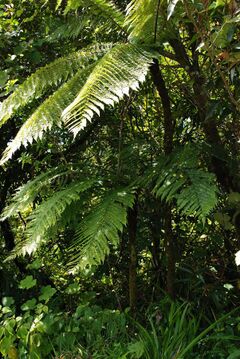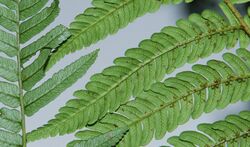Biology:Cyathea borbonica
| Cyathea borbonica | |
|---|---|

| |
| Cyathea borbonica | |
| Scientific classification | |
| Kingdom: | |
| Division: | |
| Class: | |
| Order: | |
| Family: | |
| Genus: | |
| Subgenus: | |
| Species: | C. borbonica
|
| Binomial name | |
| Cyathea borbonica Desv., 1811
| |
Cyathea borbonica is a tree fern endemic to Mauritius, Réunion and the islands of the south-western Indian Ocean. There are several natural forms and varieties.
Description
It reaches a height of roughly 2 meters, with a dark, hairy, scaly trunk. Its spreading leaves are dark green fronds. Each frond has a relatively small stem (stipe). Each leaf also divides only twice (bipinnate):
- The central midrib of the frond (rachis) branches into many horizontal leaflets (pinnae).
- Each pinna midrib bears many small leaflets (pinnules).
Forms and distribution
There are two natural Mauritian varieties, which occur mainly in the upland forest in the higher parts of the island, and are both endangered. There is one natural Reunionese variety:
- C. borbonica var. borbonica (Réunion).
- C. borbonica var. latifolia (Mauritius), which bears an umbrella-shaped crown
- C. borbonica var. sevathiana (Mauritius), which bears a funnel-shaped crown
Related species
In Mauritius, they share the island with several other tree ferns - the naturally occurring Mauritian species Cyathea grangaudiana and Cyathea excelsa - and the alien non-indigenous Cyathea cooperi which is introduced from its native Australia .
In Réunion, they share the island with the naturally occurring Réunionese species Cyathea glauca and Cyathea excelsa - and also with the introduced Cyathea cooperi.[1]
Cyathea borbonica can be distinguished from all of these other species by its small stipe and by its fronds' two-level division.[2]
The alien Cyathea cooperi can be distinguished by the red and white hairs on its new fronds.
The tripinnate fronds of Cyathea glauca in Réunion.
References
- ↑ A revision of the fern family Cyatheaceae in the Mascarene Islands (2006)
- ↑ M. Glaubrecht (2010): Evolution in Action: Case studies in Adaptive Radiation, Speciation and the Origin of Biodiversity. Springer Science & Business Media. Science. p.13.
External links
Wikidata ☰ Q3008067 entry




